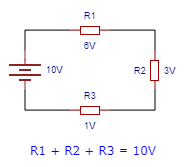Back to: Fundamentals
Voltage is the difference between electrical potentials. The unit for voltage is the volt, symbol V. A voltmeter is used to measure voltage. The volt is named after Alessandro Volta, who invented the voltaic pile, which is a form of chemical battery. Voltage can be calculated by multiplying the current (I) by the resistance (R), V = IR
In 1845, a physicist named Gustav Kirchoff created two laws, known as circuit laws. Here we are concerned with the second, known as Kirchoff’s voltage law. This states that the sum of voltage drops in a closed-loop circuit equals zero. The reasoning behind this is that in a closed-loop, no energy is lost. For this reason, the law is also known as the conservation of energy.

Figure 1 shows a circuit that demonstrates Kirchoff’s voltage law. There is a battery that provides 10V and three resistors. Resistors are components that are often used in circuits to provide a voltage drop – which is determined by its value of resistance. When we add up the voltage drops, the value is the same as the battery. If we subtract the sum of the voltage drops from the voltage from the battery, we are left with zero – satisfying Kirchoff’s voltage law!